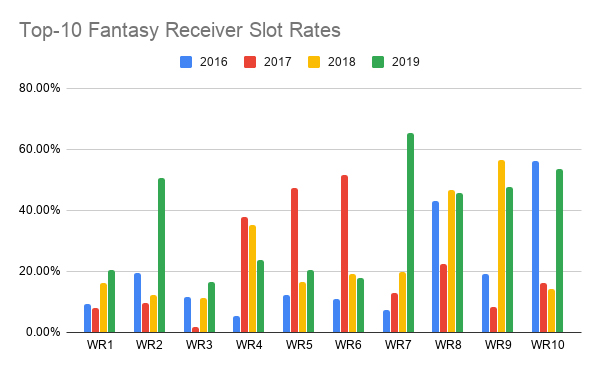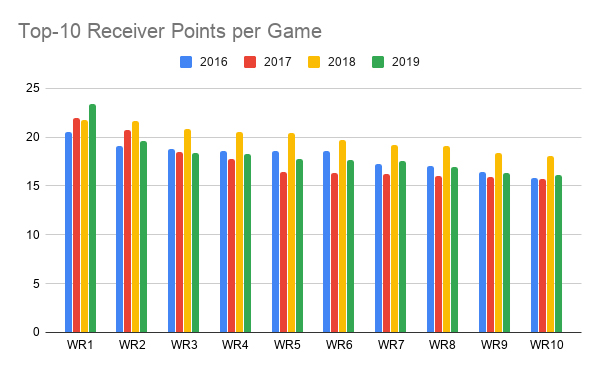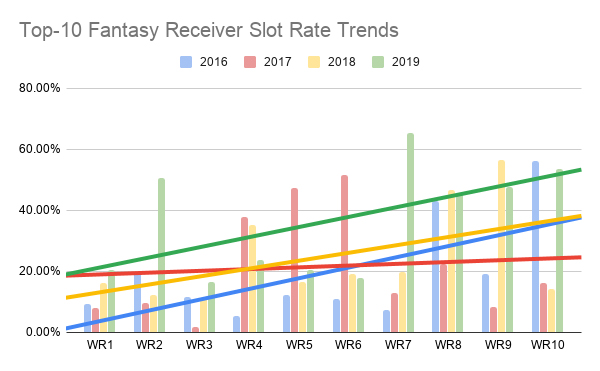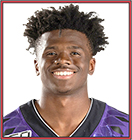AugustUpdate Camp News |
Staff Rankings
| Config Cheat Sheet
| STOMP
Draft Strategies | Depth Charts | Mock Drafts | SOS | Tools | ADP
Diehards Staff Experts Poll | Draft Simulator | University Videos
Draft Strategies | Depth Charts | Mock Drafts | SOS | Tools | ADP
Diehards Staff Experts Poll | Draft Simulator | University Videos
Is the slot Receiver Our Generation's X Receiver
By Kyle Dvorchak
 The fantasy landscape was overhauled with the advent of fading expensive running backs in drafts in recent years. Loading up on stud receivers became in vogue. However, the tides have once again turned with a new wave of workhorse running backs and changing roles of the receiver position. Now, more than ever, wide receivers aren’t 6’5” giants winning half of their 200 targets, most of which came beyond the sticks and with a defender on their back. Alpha receivers look like Michael Thomas and Chris Godwin. Athletic players who teams just want to get the ball in their hands as often as possible. Sometimes, that means moving them inside and feeding them high-percentage targets.
The fantasy landscape was overhauled with the advent of fading expensive running backs in drafts in recent years. Loading up on stud receivers became in vogue. However, the tides have once again turned with a new wave of workhorse running backs and changing roles of the receiver position. Now, more than ever, wide receivers aren’t 6’5” giants winning half of their 200 targets, most of which came beyond the sticks and with a defender on their back. Alpha receivers look like Michael Thomas and Chris Godwin. Athletic players who teams just want to get the ball in their hands as often as possible. Sometimes, that means moving them inside and feeding them high-percentage targets.
So how has this affected the top-end of the position?
I have charts.

This is the top-10 receivers in every season since 2016 by slot rate (the percentage of their snaps that came from the slot). There’s a weird blip of red in the middle, lots of tall green bars, and the left side is generally shorter. What does that mean?
The top-3 wide receivers seem almost entirely unaffected by the generation of slot receivers that has hit the NFL. Chris Godwin is the WR2—based on points per game—that sticks out but no other elite receiver has eclipsed a 21% slot rate in recent years.
So playing in the slot is bad for a receivers’ ceiling?
Not necessarily. Michael Thomas was the top-scoring receiver in 2019 and only played 20.5% of his snaps in the slot. However, 43.8% of his targets came from snaps that originated in the slot.Elite receivers aren’t made by throwing someone in the slot. They happen by an immensely talented receiver earning a swath of targets on an offense that’s at least competent enough to get him those targets.
The red blip is likely just an anomaly. However, one explanation is that 2017 was a terrible year for receivers.

The worst season at every spot after WR3 came in 2017. The awful season was caused by numerous quarterback injuries including season-ending injuries to Andrew Luck and Aaron Rodgers.
Who can survive a quarterback injury?
The league’s best passers go down and slot receivers rise to the top. The three tall red lines in the middle of the previous chart are Keenan Allen, Jarvis Landry, and Larry Fitzgerald. Two of those three receivers saw their quarterback go down—Ryan Tahhenill for Landry and Carson Palmer for Fitzgerald.Targets out of the slot have high completion rates and as Michael Thomas showed us last year, good slot routes are impossible to cover, making them supremely simple for even backup passers to complete.
Are slot targets better for fantasy?
In 2019, the average target not that did not come from a receiver in the slot generated .5 fewer fantasy points than a target headed to a slot receiver. A target with more air yards behind it—Mike Evans’ targets as an example—is going to have more upside because it's more likely to generate a 50-yard touchdown or even just 50 yards. However, points for receptions highly value a receiver’s ability to secure a catch. Volume will always be the driving factor for a player's projection and ceiling but playing in the slot is undoubtedly advantageous.That brings us to the low-end WR1s. The 2019 season saw a number of slot receivers creep into the top-10 receivers.

The trend line helps show the prevalence of slot receivers. Even in a season with Thomas and Godwin in the top-3, the end of the WR1 group was skewed more towards the slot than two of the past three seasons.
Targets shifting to the slot hasn’t created a new breed of alpha receiver but it has pushed talented players into more valuable roles across the league.
What do I do with this information?
Find players who can command a large number of targets who will also get a “slot bonus” on many of those targets.Adam Thielen
 The Vikings relieved themselves of Stefon Diggs in March which puts them in the market for a 1st-round receiver with the 22nd or 25th overall pick. Thielen was injured for a large portion of the 2019 season but in 2018, he and Diggs 16 and 15 games respectively. When they were both healthy, Diggs commanded 149 targets. No rookie in the past 15 years has earned that many targets.
The Vikings relieved themselves of Stefon Diggs in March which puts them in the market for a 1st-round receiver with the 22nd or 25th overall pick. Thielen was injured for a large portion of the 2019 season but in 2018, he and Diggs 16 and 15 games respectively. When they were both healthy, Diggs commanded 149 targets. No rookie in the past 15 years has earned that many targets.
Diggs’ targets will be spread amongst a likely rookie, Irv Smith Jr., the ancillary receiving pieces, and, most importantly, Adam Thielen. In 2018, Thielen played on every single Vikings offensive snap and 46.7% of those snaps came from the slot.
During his tenure as a Viking, Kirk Cousins 9.6 adjusted yards per attempt is when targeting Thielen is better than his connection with any other receiver.
The Vikings are experiencing a target-vacuum and Thielen is in prime position to fill that void.
Cooper Kupp
 Kupp will be the most expensive player on this list but he’s also the most underpriced. At his current ADP, Kupp is being drafted as the final WR1 despite finishing as the seventh-highest scoring receiver in the league last year. Another twist is how he got there. Kupp was used more as a role-player last season than most people will remember. He played on 80.5% of his team’s snaps (46th among receivers) even though Brandin Cooks was inefficient and fought injuries all year. Part of the reason for this was that the Rams moved toward more formations with two tight ends and were able to keep Kupp on the bench in these sets.
Kupp will be the most expensive player on this list but he’s also the most underpriced. At his current ADP, Kupp is being drafted as the final WR1 despite finishing as the seventh-highest scoring receiver in the league last year. Another twist is how he got there. Kupp was used more as a role-player last season than most people will remember. He played on 80.5% of his team’s snaps (46th among receivers) even though Brandin Cooks was inefficient and fought injuries all year. Part of the reason for this was that the Rams moved toward more formations with two tight ends and were able to keep Kupp on the bench in these sets.
Now, Cooks is out of the picture entirely after being traded to Houston. This means the Rams will be forced into leaning on Kupp more in 2020, even when they move out of two-tight end sets.
More targets for Kupp is a boon for him but also a plus for the offense as a whole. Like Thielen, Kupp is the No. 2 target for Jared Goff. His 10.0 AYA when targeted by Goff trails on Sammy Watkins.
Jalen Reagor
 Kupp and Thielen have cleared paths to WR1 status ahead of them making both of them great values in the mid-rounds of drafts. Jalen Reagor, a rookie receiver out of TCU doesn’t have a team yet but his path to a fantasy-relevant rookie campaign is similar.
Kupp and Thielen have cleared paths to WR1 status ahead of them making both of them great values in the mid-rounds of drafts. Jalen Reagor, a rookie receiver out of TCU doesn’t have a team yet but his path to a fantasy-relevant rookie campaign is similar.
Because slot targets are so QB-friendly, a rookie receiver has a great chance of making an impact early in his career by filling that role. Evan Engram and JuJu Smith-Schuster have champions of this position in recent years.
Reagor has the skillset and athleticism to join them. He broke out in his first season at TCU with 33 receptions, 576 yards, and 8 touchdowns. His final season was bogged down by the Horned Frog’s abysmal offense but in his second year, Reagor showed he was capable of carrying a team. His 1,061 yards accounted for 38.9% of TCU’s total yards through the air.
At 5’11” and 206 pounds, Reagor has the stereotypical size of a slot receiver. With 4.45 40-Yard Dash speed and 78th-percentile athleticism, he has the athletic prowess to out-produce many of the current slots in the league within a year.
